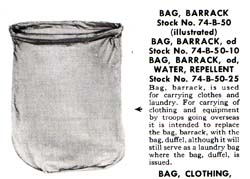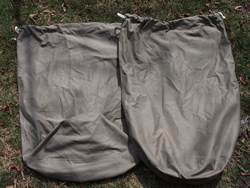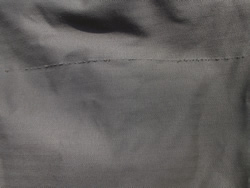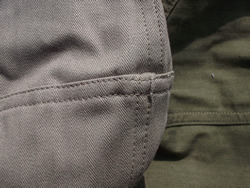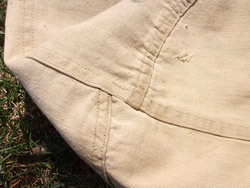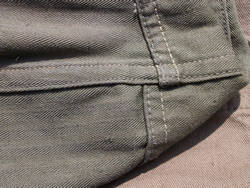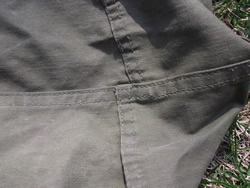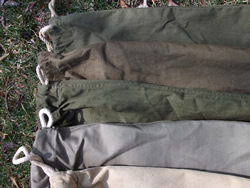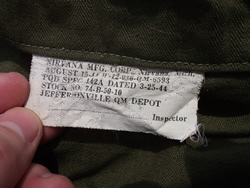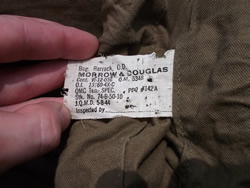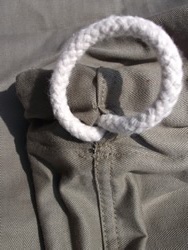At The Front Barracks Bag Review
Review Date: 4/21/2010
Author: Chris Guska
Background:
The Barracks Bag, (Bag, Barracks, Stock Number 74-B-50) was a ubiquitous item to all GI's that saw Army service during the war. Upon initial issue at the Reception Center / Camp, each GI was to receive 2 Barracks Bags as individual issue.
The ubiquitous barracks bag saw service from the interwar era through modern day - even with the introduction of the duffel bag in 1943 which was intended to replace the barracks bag in some ways.
Production Variants:
There are essentially 3 major variants of the bag as far as we're concerned as reenactors.
1.) The "M-1929" Blue Denim Barracks Bag
This is the forefather of the common "WWII" barracks bag - a round bottom bag, made from blue cotton denim, approximately 17 inches in diameter and 31 inches tall. The bag had a double draw closure with a white cotton sash cord. The construction is double needle stitched felled seams, with exception of some details of the draw closure.
This bag was issued till stocks were exhausted during the war. It is not uncommon to see these turn up in induction photos well through 1943. I would not be surprised to see these bags potentially still being issued in 1944 and 1945.
2.) The "WWII" Barracks Bag
This is pretty much the same as the early bag, with exception of no longer being made from blue denim, but rather olive drab fabric. The bags were produced from twill, herringbone twill, sateen, and ordinary flat weave cloth. Additionally, bags came in a range of colors, being specified first in Olive Drab #3, then later in Olive Drab # 7. The cord was also simplified and cheapened as time went on - from a tightly woven sash cord, to a simpler "rope" style cord.
3.) The "Post WWII" Barracks Bag
The pattern and size of the bag changed completely. At this point, these bags had transformed into a laundry bag - and the simplicity of construction followed. The bottom was no longer round, but just a squared off, sewn straight across the bottom affair. Most commonly these postwar bags are found in dark olive drab herringbone twill.
Ordering:
Ordering was quick and easy via telephone with At The Front. I ordered a pair of barracks bags for myself as part of a larger order. The order was accurately filled and delivered via UPS the same week when I ordered it.
Cost: $25.00
The Reproduction:
Overall:
The bag is made from "OD3" herringbone twill cotton fabric. The fabric feels to be the right weight and hand to it - a fairly tight weave, not feeling thin, floppy or like it would tear apart under light use. I ordered two bags, one of which was blem free on the fabric, while the other had a run about 2 inches from the top of the bag.
The seams are correctly double needle felled, mirroring the construction of originals. I specifically point this out, as its not only correct on a "stitch" basis, but because its durable. Single needle stitching is not what you want on a bag meant to carry a heavy load.
The seams are well lined up on the bottom of the bag, in some ways this is better put together than on originals. Originals are sloppy in this seam where the round bottom halves of the bag meet the sides. Here's some original examples to show how bad they can be.
The bag is the right size. It appears to have been patterned off an unissued / unwashed original. These bags were heavily used in military and postwar civilian life, being laundered frequently and shrinking over time.The color of the bag on the At the Front website appeared a bit dark - deceptively so. I thought the bag would be far "greener" than it actually is. This is just one of those reminders to me about Metamerism and Flare... I highly recommend reading my my piece on fabric color. This bag appears several different colors under different light sources. It looks greener under incandescent light than natural light.
The bag also has a pretty nice reproduction QM tag in it as well. Its a pretty typical tag - nothing embarrassing or wrong about it. The bags that I have to compare with have a later style tag in them - but I'll show nonetheless.
The draw cord is sturdy and is a pretty good match to some of the original unwashed, unused examples I was able to compare it to.
Assessment:
The good:
This bag has a lot going for it. Its the right size, it appears to have been patterned off of an unissued original.
The bad:
1 bag had a run in the fabric. I didn't bother to report it, or even attempt to exchange it. Its not a terrible flaw that will render it unserviceable or my impression "turbo-farby".
I'm not sure if this is an issue or not - nor can I speak with authority on it - but the fabric is aligned horizontally - with the HBT rows running around the bag rather than from top to bottom. I only have 2 original HBT bags, both of which are aligned vertically. Not sure if this is an issue or not, but I'll note it nonetheless. Gotta bitch about something...
Materials and construction:
Materials are good. The fabric is an appropriate weave, weight and color. The construction appears to be well done, with no loose seams. The seams are constructed as originals, on a commercial double needle machine. I'm fairly confident that this bag will stand up to real use.
Summary Pros and Cons
Pros:
Pattern is right on
Materials are good
Construction is well done and sturdy
Cons:
Fabric run / blem on the one bag
Fabric direction alignment?
Maybe that it costs $25. I’d love to see them for sale for $20 or less.I don't have much to complain about once again. I’m happy to replace an original out of my kit with this one. Once stenciled, I think the bag will look fantastic and be a really nice addition to my impression.
90th IDPG Reviews



